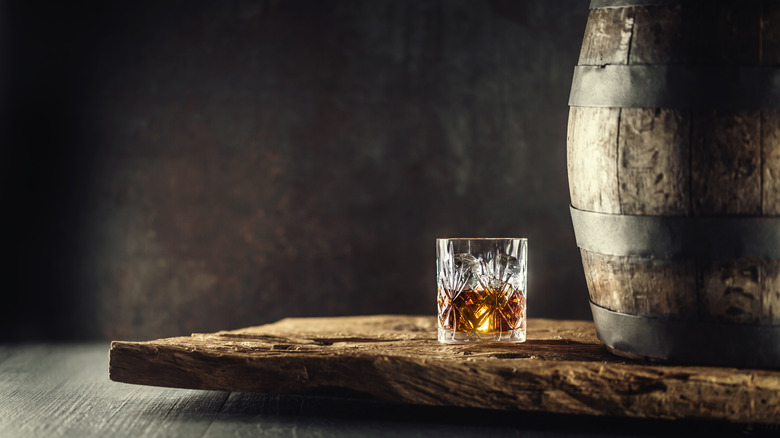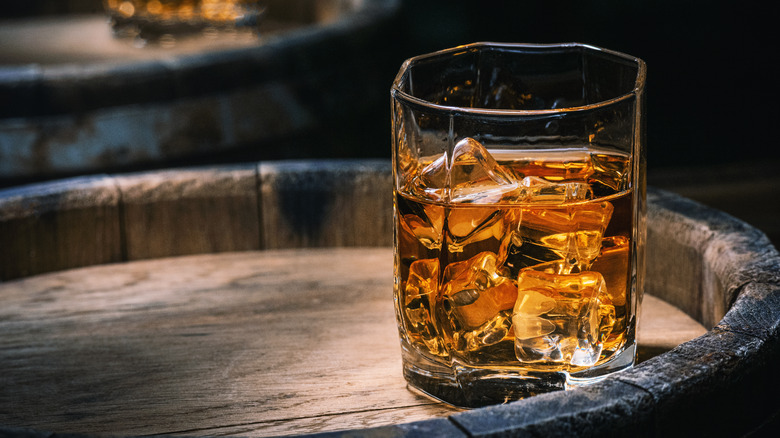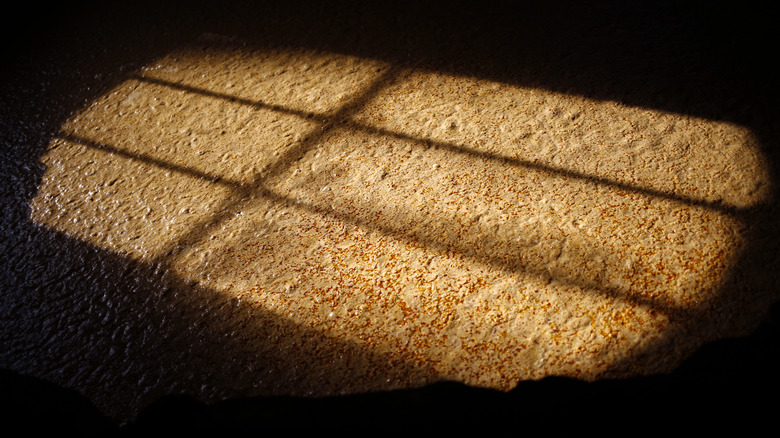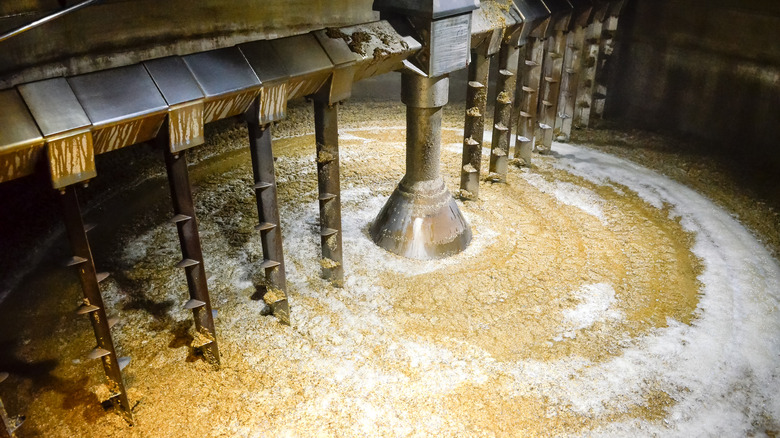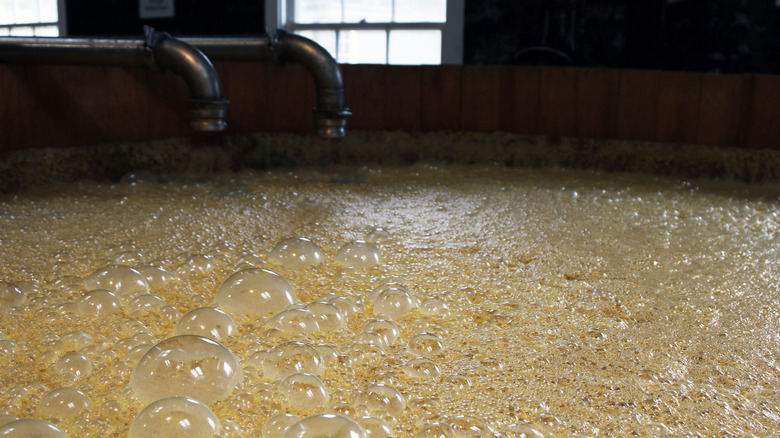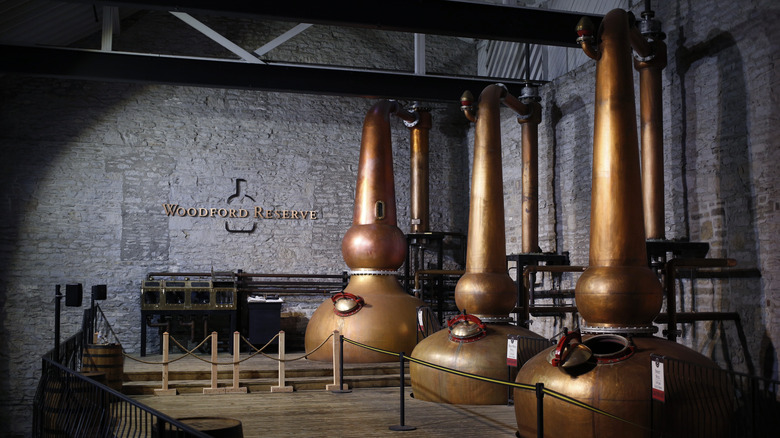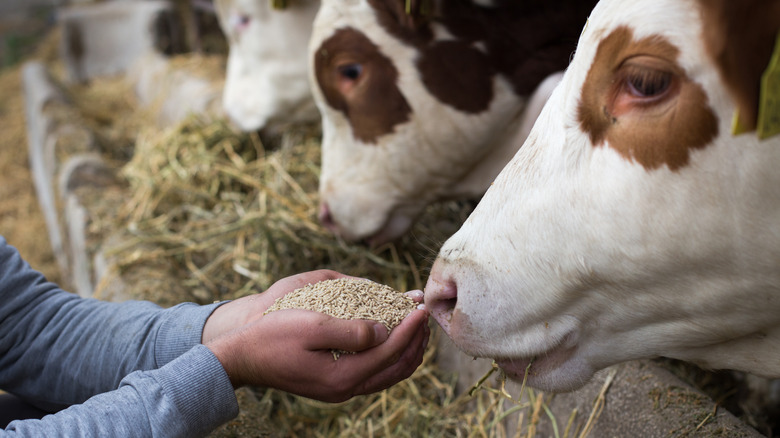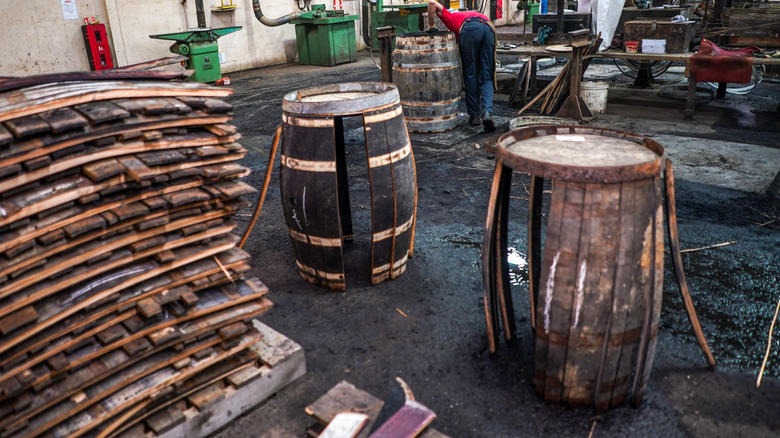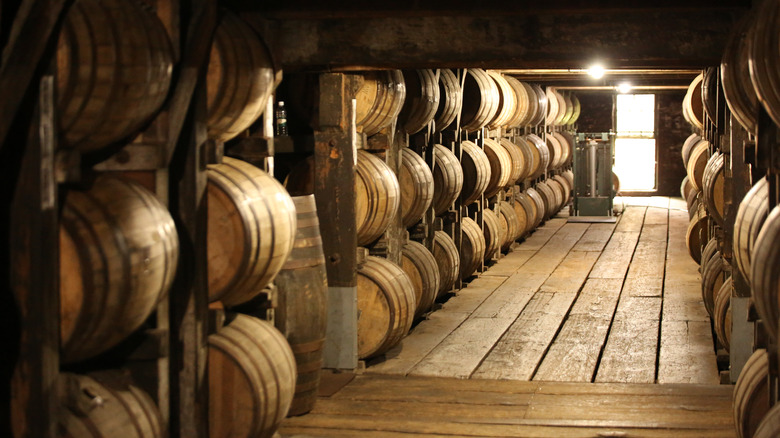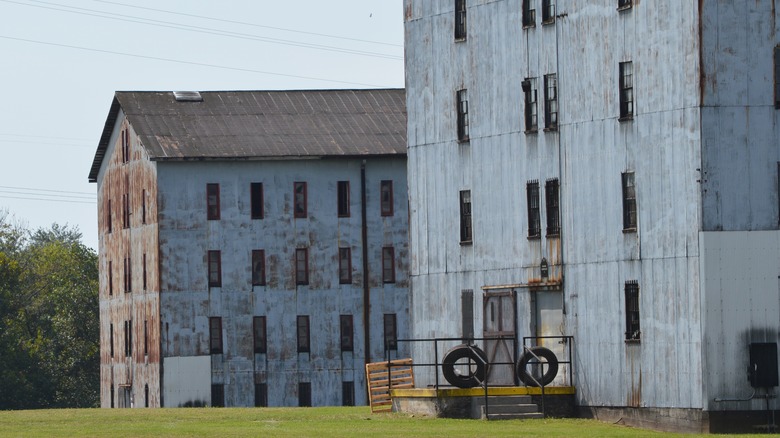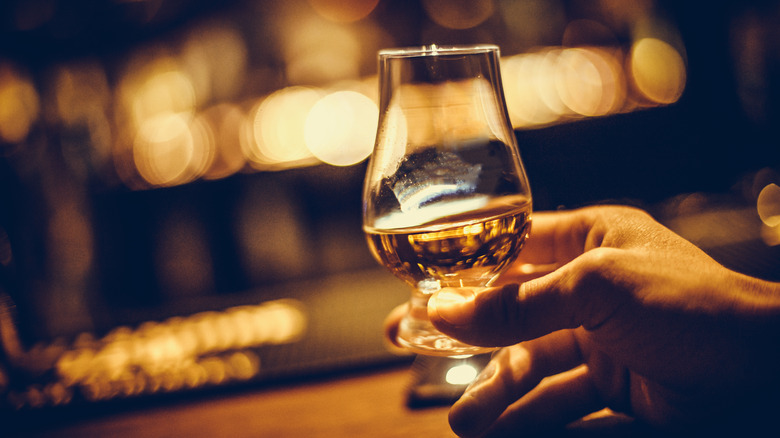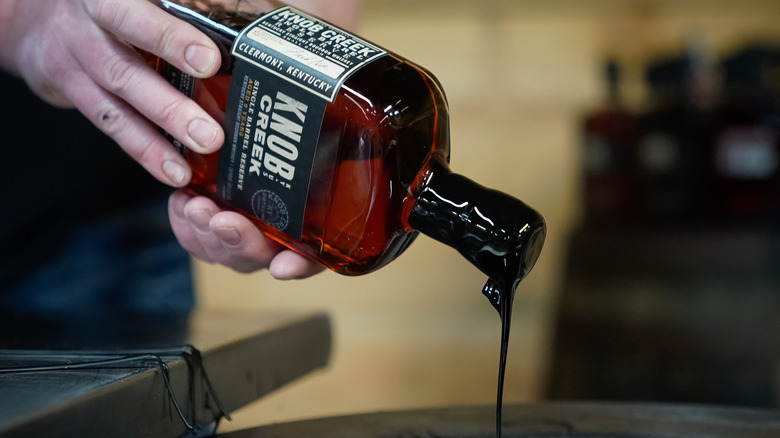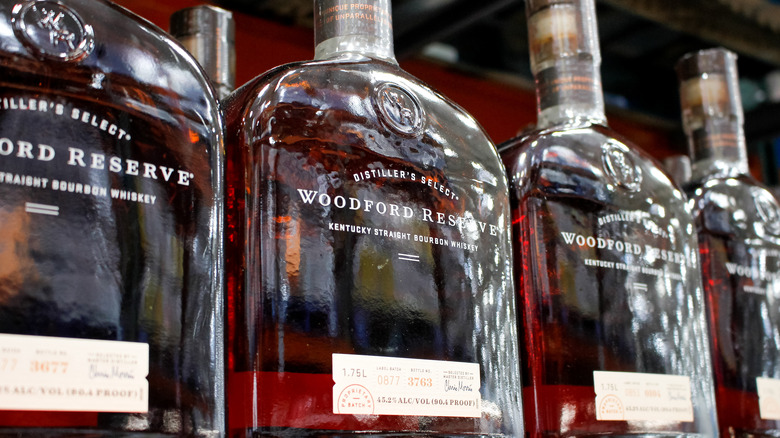This Is How Bourbon Is Really Made
Not everyone loves a smooth glass of Kentucky bourbon. That distinct flavor is one you'll either love or hate — but if you love it, there's a good chance you'll love it forever, and you'll be a stalwart whiskey drinker for life. And more and more drinkers are jumping on the bourbon train these days; in fact, some might say that there's a "bourbon boom" occurring, with bourbon production and demand at its highest in decades.
But how exactly does that whiskey make its way from the distiller to your liquor store shelf? The process is an art form and, if you've never had the pleasure of traveling the Kentucky Bourbon Trail, one that you might not be that familiar with. Sure, you know that there are barrels involved and you're pretty sure that some corn and something called a "mash" is included, but what are all the necessary steps for getting from grain to one really great glass of whiskey?
Here are the 12 primary factors that go into making your favorite bourbons.
Understand what a bourbon is
Before you can make bourbon, it's important to understand what a bourbon is and what a bourbon is not. A whiskey must meet very strict guidelines in order to be considered a bourbon and, yes, those guidelines go beyond merely being made in Kentucky (though you'll find a lot of bourbon aficionados will fight on that rule, with the Bluegrass State residents remaining firmly on the side of all-bourbon-must-be-made-in-Kentucky, whereas everyone else takes a broader approach to the definition).
Smithsonian Magazine, though, says that, according to the experts, bourbon distilling isn't technically limited to Kentucky. Instead, a bourbon must fall under six guidelines. First, it has to be made in the United States — anywhere in the United States. Secondly, it must be aged in new, charred, white oak barrels. Third, it must be at least 51% corn. Fourth and fifth, it must be distilled at less than 160 proof and barreled at less than 125 proof. Lastly, there cannot be any additional coloring or flavoring added.
Bourbon starts with a mash bill
Each whiskey, including bourbons, starts with a mash bill, which is basically the master distiller's recipe for that particular whiskey. It tells the distiller exactly what grains need to go into the whiskey from the start, in what ratios. However, remember that in order for a whiskey to be a bourbon, at least 51% of that grain ratio must be made up of corn. Other grains that can be used include malted barley, rye, and wheat. The ratios of each impact the taste of the final product. As Southern Distilling Company notes, a whiskey with more corn will have almost a syrupy flavor, while rye-heavy whiskeys are more savory. Bourbons with a heavy portion of malted barley will typically taste maltier and toffee-esque, while bourbons with a heavy amount of wheat will taste clean, with a soft, sweet undertone.
The final ratio and mash bill depend entirely on the individual distiller. The only rule, again, is that they include at least 51% corn.
Creating the bourbon mash
So then how do you go about actually creating the bourbon mash? Surely it's not as simple as just throwing some corn, wheat, and rye into a barrel and calling it a day? According to MasterClass, the correct portions of grain are combined and then added to water and yeast (typically in a very large vat). The mixture is heated and stirred, creating the bourbon mash.
But even at this point in the process, careful consideration is taken when choosing the yeast and even the water, as both impact the final product. According to VinePair, distillers will either use their own proprietary strain of live-culture yeasts that they've been growing at their distillery for decades, or they'll purchase yeast from a dedicated producer. In other words, they're not going to the grocery store and picking up a packet of dried yeast like you'd use for baking. Many distillers also say that limestone water is necessary for bourbon making — and it just so happens that limestone water is abundant in Kentucky (via WFPL).
The bourbon is left to ferment
After the bourbon mash is created via the perfect quantities of grains, as well as the right yeast and water, it's left to ferment. The fermentation process doesn't take long; MasterClass says from one to two weeks, but other distillers are finished with fermentation in as little as three days. The fermentation process allows for all of the ingredients to break down on a chemical level, creating alcohol.
Often, the distiller will add more yeast and sour mash around this time. The sour mash is a mash liquid that's been leftover from a previous batch of bourbon mash and helps the new mash reach the correct pH levels. Think of it as similar to a sourdough starter or kombucha scoby. You need a little bit of something old, to make something new. The tradition of using sour mash came about in the 1800s, to help distillers produce a consistent product over multiple batches. Today, every major U.S. whiskey distillery uses the sour mash process, but it's not entirely necessary to create a bourbon and it is possible to find some micro-distillers who do not (via Whisky Magazine).
The remaining liquid is distilled
As The Whiskey Professor explains, there are two separate distilling processes that the fermented mixture must go through before barreling. The first distillation process happens before the liquids and solids are separated. Once the mash is fermented and has a low-alcohol content, it's known as distillers' beer. It's sent into a still, where it's heated, making the alcohol vapors rise. These vapors travel through a tube that condenses the vapors, turning them back into liquid. This higher-proof liquid is reserved, while the remaining mixture that's left behind will be used elsewhere (more on that in a minute).
The reserved, higher-proof liquid is sent on to the second distillation process in a "doubler," and the proof increases even further. This liquid is almost ready for barreling and can be held in a retention tank until that time.
But what about all those liquids and solids that the vaporized alcohol left behind?
Separating the liquids and solids
After fermentation and one round of distillation are complete, the remaining mixture is strained, separating the liquids and solids. The liquid can be used as that sour mash that's added to new mash later, but the solids have a very different destination.
While some distillers may toss the solids, known as distillers' grain, others will ship the grain to farms, where it's used as livestock feed (via CNBC). While that may seem a little odd and possibly harmful to the chicken and cows for which the feed is intended — after all, this grain mixture has been soaking in a bourbon-adjacent liquid for days, could it possibly result in some very inebriated farm animals? — research says the mixture is actually a very healthy and low-cost option for farms. The Iowa Corn Growers Association notes that distillers' grains are filled with protein, fat, minerals, and vitamins, and, since about 90,000 tons of distiller's grains are produced in the United States each week, the mixture is readily (and affordably) available.
Choosing the perfect bourbon barrel
But back to the alcohol. At this point, the bourbon is waiting in the retention tank for barreling. However, before a distiller can add the bourbon to just any ol' barrel, they must choose the perfect barrel, which is a whole task in and of itself.
Barrels are produced by coopers (just a fancy name for a barrel maker) and the barrel-making process is just as important to the end bourbon as any other part of the whiskey's creation. One Eater article looked into the barrel-making process by interviewing the owners of the Adirondack Barrel Cooperage. There, coopers purchase Missouri American oak wood, which is known for being impervious to water and relatively low on tannins thanks to the growing area's heavy rain and snow. The wood is aged two to five years, then mechanically shaped into the recognizable barrel curvature. After all the wood slats are the right size and shape, a ring is attached, which keeps it all together. Then, the new barrel is heated and charred (some coopers use steam for this, while others use fire). After the barrel cools, it's cauterized, sealed, sanded, and shipped.
And only then is the barrel ready to be filled with bourbon.
Aging the bourbon
After the bourbon is in the barrel, it sits there. For a while. And just like there are a lot of rules regarding what goes into a bourbon, there are a lot of rules regarding how long a bourbon is aged. As Southern Kitchen states, a bourbon must be aged for at least two years but no more than four years if it's to be called a straight bourbon whiskey. If a bourbon is going to be called a bottled-in-bond bourbon, it must be aged for at least four years. If a bourbon is a mixture of multiple bourbons aged for multiple timespans, the number on the bottle should reflect the youngest bourbon's age.
Typically, the longer the bourbon stays in the barrel, the more flavor it develops. However, that's not always the case. Most bourbons hit peak flavor around five to 10 years and other factors, such as environment, also play a role in developing the flavor once the bourbon is in the barrel.
The bourbon barrel environment
On that note, it's important to consider the environment where the bourbon barrel is stored for the aging process, as that also impacts the end product. Most Kentucky bourbons are aged in rick houses, huge barn-like buildings that house hundreds to thousands of barrels of bourbon.
These rick houses are built in such a way that they retain the summer heat well — so well that they retain the heat all through the winter months, keeping the inside temperature warmer than the outside temperature. Still, the heat rises, creating warmer temperatures at the top of the rick house and cooler temperatures toward the bottom, as well as changes in humidity throughout the building, both of which result in slight variations in the bourbon's flavor profile based on where it was stored in the house. To combat this, sometimes, distillers will artificially heat or cool their rick houses, or move the barrels around over the years, to better control the resulting product.
Determining when it's done
So beyond just knowing how long a barrel of bourbon has been sitting in the rick house, how does a distiller know the bourbon is done? By tasting it, of course. The master distiller at a distillery will sample bourbons directly from the barrel and decide which are ready to be bottled. Master distiller Marianne Barnes told CNBC that she must be able to identify the nuances of flavor profiles of each of her distillery's brands, as well as be able to identify a barrel's proof and any defects upon tasting.
But tasting all that bourbon isn't as fun as it may sound. Barnes told the publication that she's not allowed to smoke, can't wear perfume on the job, and does "a lot of spitting." She also has to recalibrate her senses every once in a while, using scent jars to ensure she's accurately picking up on flavor notes like oak, cedar, and pepper. She can reportedly do 50 tastings of a 140-proof bourbon before her mouth goes numb, compared to the average drinker's six tastings.
The final step: bottling
Once a master distiller approves a barrel of bourbon for bottling, it can either be chilled for further development (Difford's Guide says this can remove any molecular proteins that might make the bourbon hazy or diluted after bottling) or directly bottled.
To bottle a whiskey, Whisky Advocate explains, barrels will be mechanically dumped into a trough. The whiskey is transported into a holding tank and then through an automated bottling process, though sometimes employees are used for special parts of the process, such as dipping each Maker's Mark bottle into its iconic red wax. The process is quick; Heaven Hill Distillery can reportedly fill as many as 21,000 bottles per hour.
Any leftover items from the process are, in many cases, used in a new or inventive way, such as the distiller's grain which feeds livestock, or the leftover fusel alcohol from distillation that's sometimes used in perfumes. Some distillers even use the fusel alcohol as a power source.
Making its way to your hands
From there, the bottled bourbon is shipped to your favorite local liquor store and then it's up to you to properly store your bourbon at home, so that all of that hard work on behalf of the distillers, coopers, and others doesn't go to waste.
Heaven Hill Distillery recommends that you store your bourbon in a cool, dark spot, away from heat and sunlight. Additionally, always store your bourbon bottles vertically, never horizontally, and make sure to use a sturdy shelf, where bottles won't be in direct contact with a floor or wall. Likewise, don't store your bourbon bottle near an oven, in the attic, or in the back of a car. You want to keep the bottle somewhere between the upper 60s and lower 70s. If you're collecting whiskey that you aren't putting on display immediately, consider storing it on industrial-style shelving in a (clean, dry) basement — though we also totally understand if you don't want to wait to drink that whiskey long enough to start a collection!
